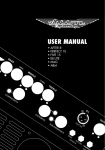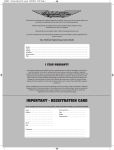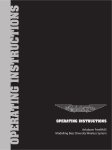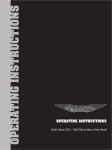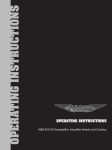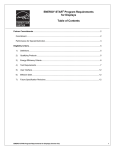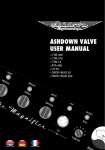Download Ashdown CTM 300 User manual
Transcript
www.ashdownmusic.com 1 USER MANUAL CTM 300 WELCOME TO ASHDOWN VALVE BASS AMPS Thank you for choosing an Ashdown Valve Series amplifier. To ensure that you receive the full benefits of the Ashdown warranty, please register your amplifier at www.ashdownmusic.com WARRANTY Your amplifier is covered by a one year warranty, against defects in materials and workmanship, for the original purchaser. Ashdown will, at their discretion, replace or repair any product or part thereof, which is found by Ashdown to be defective. This warranty shall not apply to the damage of covering, fittings or finishes when affected by carelessness, accident or extreme climate changes. Nor does it apply to normal wear and tear of parts such as valves, fuses, light bulbs, speakers, controls etc. In the unlikely event of any defect, please contact an authorised Ashdown dealer. All transport charges are to be pre-paid by the Owner. Unless your purchase is registered on-line, normal country warranty laws apply. IMPORTANT SAFETY INSTRUCTIONS This Ashdown amplifier has been designed to provide you with many years of faithful service – on the road, in a studio or in a domestic environment. By following the rules set out below, you will ensure that the unit functions safely. Valve (tube) instrument amplifiers contain very high voltages and fragile glass tubes and should therefore be handled with care. A number of important precautions which must be observed are set out below. Before using the amplifier, run through the check list below. If you are in any doubt about any aspect of the amplifier’s operation, stop using it immediately and do not resume operation until the amplifier has been thoroughly inspected by a qualified technician. 1) Storage and moving When your amplifier is not in use make sure that the power cord is unplugged from the mains outlet, and that all leads are removed from the amplifier, including jack leads and footswitch leads. Jack socket connectors are self-cleaning, so the process of plugging in and unplugging the leads when not in use will ensure that the internal contacts will be cleaned when you plug in again. Store your amplifier in a warm, dry place away from moisture and condensation. A motor vehicle or cellar may look dry but condensation can form inside the unit causing short circuits and possible electric shock. If you suspect the amplifier may have become exposed to moisture, move it to a warm dry place and leave it to dry out for at least 48 hours before attempting to use it. Condensation can also occur when you move the amplifier from a hot humid place (such as a nightclub) to a cold place (like a motor vehicle). In such instances, always move the amplifier into a warm dry room to prevent damage. When moving the amplifier, handle it as carefully as you would your instruments. Although solidly built, an amplifier is easily damaged by shock, so be careful not to drop it or allow it to fall over. Use a protective cover to protect the finish and, if you are transporting it with other equipment, make sure that the amplifier is on a solid floor at the bottom of the pile. 2 Amplifiers are heavy. Take care when lifting, always use the handles fitted to the amplifier to move it, and get help if you have to lift the amplifier to a greater height than you feel comfortable with. Never attempt to operate the amplifier after it has been dropped. Take it to a qualified technician and have it checked before using it again. 2) Leads and plugs Your amplifier contains possibly lethal voltages and must therefore be connected to the mains using the correct power cord, which is a three terminal type with a ground connection. The power cord supplied with the unit should be of the correct type. If it does not fit your mains outlet consult your dealer or a qualified electrician for advice before attempting to use the amplifier. Never modify the power cord or attempt to use it with a two pin outlet. Store all your leads in a dry case and take care when packing them away. All leads, including guitar leads, are easily damaged with careless handling, so it is a good idea to carry a spare lead of every type you use. Flexible power cords get damaged very easily. At the first sign of damage, discard it and purchase a new one. Always replace the power cord with one of the same type. Moulded cords are the best choice with both plugs permanently fitted to the cord. When using your amplifier and other equipment it is a good idea to connect to the supply using a unit known as an R.C.D. These units are not expensive and offer the user additional protection against electric shock. An electrical shop should be able to supply you with a suitable unit. 3) Before Use Inspect your amplifier for damage before use. Check each lead for damage before you plug them in to the amplifier, and ensure that the loudspeaker is connected before you switch the amplifier on. Never try to operate the amplifier without the speaker connected. If you do, serious damage to the amplifier will result which will be very expensive to repair. Double check the connections you have made to your amplifier and make sure you have connected the speaker to the correct outlet socket that matches the cabinet you are using. The impedance of the speaker is important and is usually shown on a plate affixed to the back of the cabinet, so if the cabinet is 16R (Ohms) then you plug into the 16R outlet on the amplifier. 4) Using the amplifier When you set the amplifier up for use, it is important that you adhere to the following rules: Place the amplifier away from sources of heat, including radiators, etc. The amplifier itself will get hot in normal use. Make sure that all the grilles on the amplifier are not obstructed in any way so that cooling air can circulate through the amplifier. Do not place anything on or behind the amplifier that might restrict the flow of air. This includes items of clothing, or other equipment. Do not place the amplifier in such a position where it may get splashed with liquid or water, e.g. near tables of drinks or near equipment that contains water, e.g. smoke and bubble machines. Never stand bottles or containers of liquid on the amplifier. If any liquid is accidentally spilled into the amplifier, unplug it from the mains supply immediately and take the amplifier to a qualified technician for inspection. 7) Warnings used on this equipment The exclamation mark contained within a triangle is intended to alert the user to important operating and servicing instructions contained in the literature accompanying this product. The lightning flash within a triangle is intended to alert the user to the presence of un-insulated dangerous voltage within the product enclosure that may be of sufficient magnitude to constitute a risk of electric shock. Do not place objects on the amplifier that could fall inside and cause a malfunction, e.g. coins, tools, etc. 5) Sound level The level of sound or ‘volume’ you choose to use will mainly be dependant on the size of the room you are playing in and you should use the volume level that gives you the desired results. Always operate the amplifier at the lowest level you can in any given situation. Each room will have a sweet spot. Play at too low a level and the instrument will not react with the amplifier, too high and the instrument will be unplayable. In all cases you should use a level that you feel comfortable with. The Human ear is a very sensitive instrument and can easily be permanently damaged by exposure to the high sound pressure levels that can be produced by this type of amplifier. Do not operate for prolonged periods of time at high volume without suitable ear protection, or at a level that causes you discomfort in any way. If you experience any hearing loss or ringing in the ears you should consult a doctor or audiologist. 6) Fuses and ratings Your amplifier is fitted with several fuses to protect yourself and the expensive electronics inside from damage in the event of a malfunction within the amplifier. The size and rating of the fuses has been calculated to offer the most protection from damage possible. Various circumstances can lead to fuse failure. It is recommended that you familiarise yourself with the type and rating of the individual fuses fitted to your amplifier and carry spare fuses clearly marked with you as replacements. Occasionally a fuse will fail as a result of a power surge in the supply or as a result of incorrect connection of the loudspeaker. It is permissible to replace the damaged fuse with one of the same type and rating as stated on the rear panel of the amplifier, having first unplugged the amplifier from the mains supply and allowed it to cool down. If the fuse keeps blowing this indicates that there is a more serious fault within the amplifier such as a damaged tube. In this event you must take the amplifier to a qualified technician for repair. Never fit a fuse larger than the recommended rating. The fuses fitted to you amplifier are ‘Anti Surge’ or ‘Slow Blow’ or ‘Time delay’ type fuses, and have the prefix T or H in the part number. So, for example, a 5 Amp fuse would be T 5A H. The exact rating for each particular fuse can be found next to the holder in which that fuse fits. If you are not sure what to buy when purchasing replacements, take the amplifier with you and show the rear panel to the retailer. This highlights the presence of dangerous voltages within the equipment enclosure. Never try to operate the unit out of the enclosure. 8) Grounding Instructions This product must be grounded (earthed). If it should malfunction or break down the grounding provides the path of east resistance for the electric current, to reduce the risk of electric shock. This product is equipped with a power cord which contains a grounding conductor and a grounding plug. The plug must be plugged into a compatible mains outlet that is properly installed and grounded in accordance with the local electrical safety codes applicable to your country. DANGER!! Improper connection of the grounding conductor can result in the possibility of an electric shock. If you are in any doubt about the ground connection check with a qualified electrician before using this product. NEVER modify the mains power cord. Have a suitable mains outlet fitted! The wires contained within the supplied power cord are colour coded as follows: GREEN & YELLOW – GROUND OR EARTH CONDUCTOR BROWN – LIVE CONDUCTOR BLUE – NEUTRAL CONDUCTOR 9) Other markings Other markings appear on the rear panel of the amplifiers as follows: back of the amplifier has some other markings on it as follows; Directs you to recycle this product by taking it to a disposal area for electronic waste when you have finished with it, and not dispose of it in the normal household waste. 3 RoHS Indicates that the product contains only the permitted levels of substances known to be hazardous to your health. 2001/95/EC Indicates that the product has been constructed to European Harmonised Standards and is intended to show that the product is safe to use. At present, the manufacturer can selfcertify. Relates to an independent safety testing laboratory and shows that the product has been subjected to, and passed, a series of safety and quality tests and indicates that the product meets all the criteria for sale in Canada and the USA. Note: The CE mark attached to these products means it conforms to EMC(89/69/EEC) ,(93/68/EEC) and LDV(72/23/EEC). Ashdown Amplifiers reserve the right to change specifications without notice. E & O E. All contents © Ashdown 2012. Ashdown Amplifiers reserve the right to change specifications without notice. E & O E. All contents © Ashdown 2012. www.ashdownmusic.com www.ashdownmusic.com 3 LINE INPUT - This 1/4” jack socket is used to connect the output of line level devices such as samplers and sound modules. VU SPEAKER OUTPUTS - There are dedicated Speakon connectors for 2, 4 and 8! load speaker cabinet configurations. It is important that the correct output or outputs are used to match the impedance load of your cabinets. Please refer to the diagrams later in this manual. OFF/PREHEAT - Use this switch to pre-heat the valves, bringing them up to the correct operating temperature before performing. Front Panel FRONT PANEL FACILITIES INPUTS - There are two instrument inputs marked LOW and HIGH. The LOW input is highly sensitivity and also high impedance to suit the output from PASSIVE (Low Output) basses - The HIGH input is low sensitivity and lower impedance to suit the output from ACTIVE (High Output) basses. Plugging an active (High Output) bass into the LOW input will overload the input, creating a fatter, warmer and more distorted sound. Experiment by plugging your bass into either input to achieve the desired sound. EFFECTS SEND AND RETURN - These 1/4” jack sockets should be used to connect to an external effects device or pedal board. The EFFECTS SEND output should connect to the INPUT of the effects unit, and the output of the effects unit should be connected to the EFFECTS RETURN input. EQ CONTROLS - Use the MIDDLE, BASS and TREBLE controls to effect the overall tone of the sound. The MID SHIFT switch causes the MIDDLE control to operate on higher frequencies in the up position, and lower frequencies in the down position. The BASS SHIFT switch causes the BASS control to operate on deeper frequencies in the up position, and less deep frequencies in the down position. The BRIGHT switch adds an overall brightness to the sound when in the up position. (Note: The BRIGHT switch is not effective when the GAIN control is set to full). GAIN - This controls the level of the signal sent to the MASTER section. To achieve a cleaner sound, turn the GAIN control down and the MASTER up. To achieve a richer, more distorted sound, turn the GAIN control up and the MASTER down. MASTER - This controls the overall output of the amplifier. MUTE - In the up position, this switch mutes the out put of the amplifier (useful for tuning, etc.). PRE/POST - This switch determines whether the signal from the DI OUTPUT (see Rear Panel Facilities) is taken before/PRE the EQ section (down position) or after/POST (up position). VU METER - The VU meter provides a visual indication of the output level of the amplifier. It also acts as a bias meter, please see the following page for more details. STANDBY/FULL - No signal is sent to the speakers when this switch is in the STANDBY position. Switch to FULL when you are ready to perform. THE VU METER The VU meter fitted to the CTM is a dual function meter detailed as follows: By using the push button selector switch marked “AUDIO / BIAS” the functions are accessed in the following manner: WILL STILL WORK AT REDUCED POWER IDEAL SETTING KEEP OUT! DO NOT SET ANY TUBE THIS HIGH 1/ “AUDIO” - In audio mode the meter is set to read the audio output of each of the six power tubes and each can be measured by utilising the rotary selector switch on the front panel. Whilst playing this is the normal mode of operation of the meter and the reading obtained will be a direct indication of the power being produced by each output tube, the meter is calibrated so that when the needle reaches the start of the red section the power tube being measured will be producing maximum clean volume. The switch can be rotated to select any of the power tubes and its relative output will be indicated on the meter, note that when performing this test you will need to play at equal volume for each test. 2/ “BIAS” - In this mode the meter will glow RED. To check the bias of the output tubes proceed as follows: Run the amplifier for at least 10 mins to allow the output tubes to fully heat up with the amplifier set to mute. Standby on. Select.. Tube 1 and with an insulated jewelers screwdriver gently adjust the trimmer situated on the rear panel. The reading to aim for is the needle just at the start of the red ie 0db. Note that although each tube can be adjusted individually it is possible to get tubes that cannot be adjusted to the correct reading, these can still be used providing the reading is not in the red, a lower reading is acceptable and will note impact audibly on the power output or sound quality of the amplifier. Please also note that the trimmers are 25 turn types to make adjustment easy, This type of adjuster has no end stop so if you reach a point where the adjuster will not give any more adjustment then the output tube will have to be replaced if the reading is to high ie in the RED. Repeat this for each of the six output tubes in turn. RETURN THE METER TO “audio” MODE AFTER BIASING. DO NOT RUN THE AMPLIFIER IN BIAS MODE WHILST PLAYING. Note there is a protection fuse fitted to each of the output tubes and if no reading is obtained on the meter this fuse will have failed. The protection fuses are situated next to the output they are protecting the correct rating is 315Ma quick blow, in the event of a blown fuse they MUST be replaced with fuses of the correct rating and type. A continually blowing fuse would indicate either an incorrectly biased output tube or a defective output tube. Rear Panel REAR PANEL FACILITIES DI OUTPUT - This 1/4” stereo jack socket is used to connect the amplifier to a low impedance, balanced input on a PA system or recording mixer. The signal can be taken PRE or POST EQ (see above), ie with or without the tone shaping added by the EQ section of the amplifier. 4 Ashdown Amplifiers reserve the right to change specifications without notice. E & O E. All contents © Ashdown 2012. Ashdown Amplifiers reserve the right to change specifications without notice. E & O E. All contents © Ashdown 2012. www.ashdownmusic.com www.ashdownmusic.com 5 www.ashdownmusic.com Ashdown Design & Marketing Ltd Stevens Farm (The Stables), Mashbury Road, Chignal St James, Chelmsford, Essex CM1 4TX




